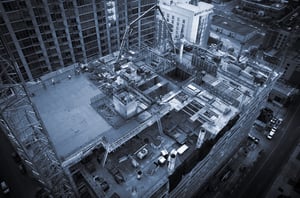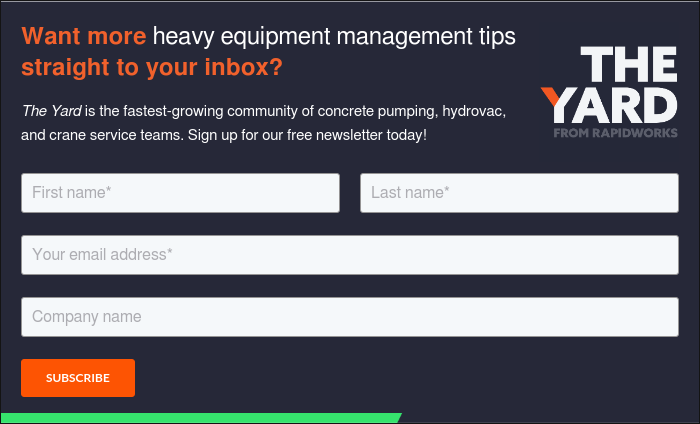
Extend Concrete Pump's Lifespan: 5 Maintenance Challenges and Fixes
Concrete pump maintenance can have a bigger impact on your bottom line than you may think. Having a proper preventive maintenance schedule can help extend your equipment’s lifespan and reduce your downtime, helping you maximize the efficiency of your assets and preventing your customers from experiencing delays.
Let’s take a look at the biggest challenges for concrete pump maintenance and how to overcome them.
We'll cover:
-
5 Critical Maintenance Challenges for Concrete Pumps and How to Solve Them
-
Extend Your Concrete Pump's Life Cycle Through Preventive Maintenance
5 Critical Maintenance Challenges for Concrete Pumps and How to Solve Them
Concrete pumps can help your business become much more productive, but they also have unique maintenance challenges that can affect your bottom line if you don’t deal with them. Knowing about these common problems and having strategies to tackle them can help you minimize your downtime and extend the life cycle of your equipment.
1. Wear and Tear on Delivery System Components
The Challenge: Pipeline and Valve Deterioration
Your concrete pump’s delivery system takes on tremendous force during normal operations. The highly abrasive concrete slurry creates constant friction against the pipeline walls, which causes a gradual thinning of the metal components.
This deterioration is even faster when you're pumping harsh mixes with a larger aggregate or when operating at higher pressures to reach greater distances or heights. What’s worse is that by the time you notice concrete leaking from the pipeline connections or valves, you’re already losing efficiency and risking unexpected breakdowns as you pour.
The Fix: Proactive Replacement and Cleaning Protocols
Implementing a systematic rotation and replacement schedule for wear parts saves you money and prevents pump failures. Track the approximate yardage pumped through each section of the pipeline and establish replacement intervals based on the manufacturer's recommendations, usually between 15,000 and 30,000 yards.
To maximize the lifespan of each component, always:
- Rotate pipeline sections regularly to distribute wear evenly.
- Inspect valve seats and seals weekly for early signs of deterioration.
- Use appropriate lubricants that are specifically designed for concrete pumping equipment.
- Consider upgrading high-wear sections to hardened materials for an extended service life.
2. Hydraulic System Failures
The Challenge: Contamination and Pressure Issues
Your concrete pump relies on its hydraulic system to generate the immense force needed to move materials through the delivery system. This complex network of components works under extreme pressure, making it especially vulnerable to contamination and wear.
Even microscopic particles entering the hydraulic fluid can act like sandpaper against precision-machined surfaces. This means your hydraulic system's efficiency will drop, and you’ll end up with slower cycling times and inconsistent concrete delivery.
The Fix: Regular Fluid Analysis and System Inspections
Create a regular sampling program to analyze your hydraulic fluid. These laboratory tests can identify contaminants and detect metals that indicate internal component issues are present before they start affecting your bottom line. Just a quarterly sampling schedule should give you enough data to track your system's health without excessive testing costs.
Your maintenance schedule should include:
- Checking all hydraulic fluid levels daily
- Inspecting all hydraulic connections weekly for leaks
- Replacing filters according to the manufacturer’s specifications, not just when they look dirty
- Monitoring system pressure during operation to identify unusual fluctuations
3. Boom Structural Integrity Problems
The Challenge: Stress Cracks and Alignment Issues
The boom assembly on your concrete pump experiences incredible amounts of stress during operation and transportation. Each extension and placement creates loading forces that test welded joints and structural components.
This stress is strongest at pivot points and section connections, which makes them especially vulnerable to metal fatigue and cracks. If the stress creates alignment issues, you could experience cascading problems throughout the boom system that affect its accuracy and potentially lead to unsafe conditions.
The Fix: Scheduled Inspections and Load Testing
Implement a comprehensive boom inspection program that goes beyond visual checks. Use dye penetrant or magnetic particle testing on the most important welds and high-stress areas to detect cracks before they’re visible to the naked eye. These testing methods can identify problems while they’re still repairable, which can save you from lots of downtime and expensive repairs.
You can keep your boom at optimal performance by:
- Lubricating all pivot points and brushings according to the manufacturer’s specifications
- Confirming that all boom sections are properly aligned at least once a quarter using laser measurement tools
- Checking the tension support cables and replacing any that are showing signs of wear and tear
4. Concrete Buildup in Hoppers and Pipes
The Challenge: Performance Reduction and Blockages
Concrete residue that remains in your equipment after each job can complicate things. Every surface that contacts concrete, from the hopper to the delivery pipe, can accumulate buildup that reduces the flow capacity and efficiency. This buildup happens slowly, which can cause operators to compensate by increasing the pressure rather than addressing the underlying issue.
The most frustrating part is that concrete buildup compounds on itself. The first deposits create irregular surfaces that catch even more concrete, accelerating the accumulation process. Once there’s a significant buildup, you’ll be dealing with more fuel consumption and slower pour rates.
The Fix: Thorough Cleaning Procedures and Proper Washout
Design a strict end-of-day cleaning protocol to prevent buildup. Train your operators to recognize that a proper cleanout extends the equipment's life and reduces your operating costs. That’s why the cleanup should be a non-negotiable part of every job, regardless of schedule pressures.
For overnight or longer shutdowns, it’s a good idea to apply a release agent to hopper surfaces after cleaning. These products create a barrier that prevents concrete from bonding to metal surfaces and makes the next day’s cleanup easier and more effective.
5. Power System Maintenance Complications
The Challenge: Engine and PTO Performance Issues
Your concrete pump’s power system has unique challenges compared to other pieces of construction equipment. The constant cycling between high loads and idle times creates stress on engine components and power takeoff systems.
Unlike equipment with more consistent usage patterns, concrete pumps go through massive fluctuations that speed up the wear on their parts. When these components begin to fail, they create intermittent problems that are difficult to diagnose and can cause inconsistent performance, which would frustrate any operator.
The Fix: Comprehensive Power System Service Schedule
Create a dedicated maintenance schedule specifically for your pump’s power system that goes beyond basic engine service. This schedule should account for the unique operating conditions of concrete pumping and include more frequent inspections for components dealing with continuous stress.
Extend Your Concrete Pump's Life Cycle Through Preventive Maintenance
Implementing a structured preventive maintenance program can completely change how long your concrete pump lasts. This will reduce your total ownership costs by letting you operate your equipment longer, as machines that receive consistent care outlast those that don’t.
Here are just some of the benefits you can expect:
- Lower costs: Emergency repairs can cost up to five times more than planned maintenance, even if it’s the same repair. This cost multiplier comes from emergency service premiums and expedited shipping, which can't be avoided when a customer is already waiting for the concrete pump to get the job done.
- Reduced downtime: Planned maintenance can be scheduled during off-hours or slower periods to minimize service disruptions. When a pump unexpectedly fails during a pour, you might also be on the hook for contractual penalties. Most importantly, your customers will lose trust in your company if your services aren’t completed on time.
- Maximizing resale value: Well-maintained concrete pumps can retain their resale value better than worn-out ones. Buyers pay premium prices for equipment with documented care because they can better predict its future performance and maintenance needs.
Building an Effective Maintenance Documentation System
Creating a comprehensive concrete pump maintenance guide turns scattered service into a well-oiled machine. You can now use a modern documentation system to capture everything from daily inspections to major repairs.
Here’s how:
- Assign a unique identifier to each concrete pump in your fleet.
- Create standardized inspection checklists for daily, weekly, monthly, quarterly, and annual service points.
- Implement a digital system that timestamps all maintenance activities.
- Record all fluid additions and replacements to track consumption patterns.
- Document every repair with specific details about the parts replaced and any modifications made to prevent recurrence.
- Generate regular reports comparing your actual maintenance costs against your budgeted amounts.
Streamline Your Maintenance Program With RapidWorks
RapidWorks is here to help with Rapid Fleet, which turns concrete pump maintenance from a reactive burden into a strategic advantage for your business. Our comprehensive maintenance solution helps you track your service history, schedule preventive maintenance, and stay on top of your equipment's health across your entire fleet in real time.
Frequently Asked Questions
What is the average life cycle of a concrete pump with proper maintenance?
The expected life cycle of a concrete pump is 15 to 20 years, or 15,000 to 20,000 hours of pumping time. Regular maintenance can extend this lifespan considerably, with some properly serviced units lasting as long as 25 years.
How often should I replace the wear parts on my concrete pump?
Wear part replacement intervals depend mainly on the volume and type of concrete pumped rather than calendar dates. Most manufacturers recommend inspecting wear rings and cutting rings after 15,000 cubic yards of material.
What are the most important daily maintenance checks for concrete pumps?
The most important daily checks are for hydraulic fluid levels and quality, checking all hoses for leakage, measuring engine oil and coolant levels, and confirming that all moving parts are properly lubricated.
How can I train my operators to better maintain my concrete pumps?
Start by assigning clear maintenance responsibilities for operators versus mechanics, with a formal training program that includes both classroom and hands-on components. Create simple, visual inspection checklists that operators complete every day, with photos showing the components and any warning signs of potential problems.
